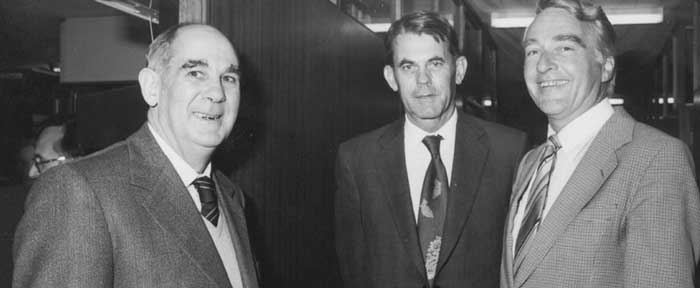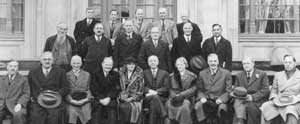ACER was established in Melbourne, Australia, in 1930 with a grant from the Carnegie Corporation. From a staff of five, ACER has grown into one of the world’s leading educational research bodies with an expanding international presence. ACER has more than 430 staff working in offices in Adelaide, Brisbane, Dubai, Jakarta, Kuala Lumpur, London, Melbourne, New Delhi, Perth and Sydney.
Prior to the establishment of ACER there had been no educational institution with a nation-wide interest. The first research undertaken was: the standardisation of scholastic and mental testing for Australia; a study of the number of children aged 10 to 18 in each school grade or type of occupation; and the fundamental problems of the primary school curriculum.
ACER’s early focus was on research, rather than service activities, and making ACER a clearinghouse of research information, with an emphasis on primary and secondary education.
ACER has been instrumental in the implementation, management and reporting of large-scale international surveys such as the Trends in International Mathematics and Science Study (TIMSS), Programme for International Student Assessment (PISA), Progress in International Reading Literacy Study (PIRLS), the IEA International Civic and Citizenship Study (ICCS) and the IEA International Computer and Information Literacy Study (ICILS).
The early years
ACER developed as:
- a centre devoted to the scientific study of education;
- a source of reference on what was the best and latest in educational thought and practice; and
- a supporter of progressive education.
During the Second World War, ACER was involved in psychological testing for personnel selection to the Australian Armed Services and government departments. ACER also worked on publications dealing with evacuation possibilities, and advised the Department of Post-War Reconstruction in Australia. For the three years from 1942 ACER was mostly concerned with the war effort, with regular work suspended. Its war time work helped lead to government financial support from 1946 and confirmed it as a significant national institution in Australia.

Post-war years
ACER’s focus widened to include more emphasis on testing. Work included: a large growth in library work; establishment of a semi-autonomous test division; conferences of test users; research into test theory; Australia-wide curriculum survey; university study to determine predictions of academic success; and the beginning of studies into adolescence and unemployment.
Recent development
ACER has grown rapidly in recent decades, opening its Sydney office in 2002, followed by offices in Dubai and New Delhi in 2004, Brisbane in 2006, Perth in 2007, Adelaide in 2009, London in 2014, Jakarta in 2015 and Kuala Lumpur in 2018.
-
1928
James Russell from the United States visits Australia on behalf of the Carnegie Corporation to assess the state of education and investigate appropriate means of assistance.
-
1929
Representatives from each of the states (except Queensland) and Executive meet to form a constitution. Official title ‘Australian Educational Research Council’ accepted.
-
19301930
February. Australian Council for Educational Research established (its name being changed at the first council meeting) with the agreement of a grant from the Carnegie Corporation.
1930ACER commences operation. K.S. Cunningham appointed first Executive Officer, and serves from 1930-1954.
1930First ACER publication, Educational Research Series No. 1, Individual Education, by C. Fenner and A.G. Paull.
1930sIQ tests gain popularity.
1935A Library Group established and runs until 1948. ACER is instrumental in setting up free library services in Australia.
1937ACER hosts the international New Education Fellowship Conference in Australia. The conference begins in Brisbane in August, and concludes in Perth seven weeks later after moving to other capital cities. The conference is a huge success, with more than 8000 people attending.
1939Funding from Carnegie Corporation ceases. ACER has saved some of the initial grant money, which keeps the organisation afloat during the war years until government support becomes available in 1946.
-
1940
ACER begins aptitude testing with army recruits.
-
19501955
Dr W.C. Radford commences as Director, and serves until 1976. Radford was previously Assistant Director.
1957ACER establishes the Australian Journal of Education, which is still published today.
1958ACER office moves from Collins Street to Lonsdale Street, Melbourne.
-
19601962
Co-operative Scholarship Testing Program (CSTP) for testing for scholarships to independent schools begins.
1963ACER office moves to Hawthorn.
-
19771977
Dr J.P. Keeves appointed Director, and serves until 1985.
-
19851985
Dr Barry McGaw appointed Director, and serves until 1998.
-
19901994
ACER office moves to current head office in Camberwell.
1997ACER Press established.
1998ACER selected to lead international consortium running OECD Programme for International Student Assessment (PISA). Continues until 2015. ACER still conducts the Australian component of the study.
1998Dr Geoff Masters appointed Director (title later changed to chief executive officer).
-
20002001
ACER a founding member of the Asia Pacific Educational Research Association (APERA) which links organisations across the region.
2002Sydney office opens in January.
2003Government funding to ACER ceases. ACER had been receiving a small portion of its income from the Commonwealth and State governments since 1946.
2004Dubai, India and UK offices open.
2004ACER acquires Educare News, which is relaunched as Teacher Magazine.
-
20052005
Ken Rowe chairs National Inquiry into the Teaching of Literacy for the Commonwealth Government.
2006Brisbane office opens.
2006Report on options for an Australian Certificate of Education delivered to Department of Education, Science and Training and released publicly in March.
2006Over $4.6 million worth of income is collected via the web, compared to $1.2 million in the previous year.
2007Perth office opens.
2007Ecommerce turnover during 2006-07 almost doubles compared to the previous financial year, with over $8.4 million worth of income collected via the internet.
2007Camberwell Road building sold.
-
20082008
Railway Parade building opens. Most Melbourne staff are now based in the main office in Prospect Hill Road, Camberwell, which is connected to the adjacent Railway Parade building.
2008ACER opens Operations Centre in Mulgrave.
2009CEO Professor Geoff Masters invited to participate in the national 2020 Summit discussions of the Rudd government’s productivity agenda in April.
2009ACER office in India changes from a ‘liaison’ office to a wholly owned subsidiary – Australian Council for Educational Research India Private Limited.
2009ACER CEO Professor Geoff Masters reviews literacy, numeracy and science standards in Queensland primary schools.
2009The number of ACER staff exceeds 300 employees.
-
20122012
ACER online assessment and reporting system launched, making the whole suite of PAT tests available online for the first time.
-
20132013
More than one million assessments successfully completed through the ACER online assessment and reporting system.
-
20142014
ACER registered as a higher education provider by the Australian Government Tertiary Education Quality and Standards Agency.
2014Teacher magazine relaunched as an online publication.
-
20152015
ACER Jakarta office opens.
-
20162016
ACER admitted to official partnership with United Nations Educational, Scientific and Cultural Organization (UNESCO).
-
20182018
ACER Kuala Lumpur office opens.
2018More than 14 per cent of ACER’s 430 employees based outside Australia.
